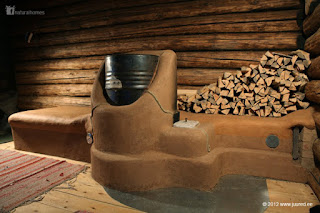This is a BIG area - and one dear to my heart.
It is also probably the most common building method in the world.
Much of the globe's population has and still does live in Earth buildings of one type or another.
There are even multi storey Earth homes in several parts of the world.
Of the many different types of construction, I'll begin with my favourite - Poured Earth.
Sometimes known as Formwork Cob, and more recently - Cast Earth.
As with Rammed Earth, it is usually built with formwork - pretty much like a concrete wall. The difference is that the usual mix is 90% earth and 10% cement as a binding agent. Water is added, the mass is churned somewhat, then poured into the formwork as a wet mix. Within a short space of time the forms are removed and presto.....instant wall.
To my eye they are also a very pleasing wall. Not quite as colourful as Rammed Earth (where layers are often added for a pattern or contrast) but a smoothly homogenous mix of a more subtle colour and pattern.
Poured Earth is normally made with a soil more on the sandier end of the scale, rather then the clayey one.
If no suitable soil is available, a very good substitute is RoadBase. This is a very uniform product used by Local Councils everywhere, and it is made to a specification.
The pictures above show walls made with small forms, but larger ones are also common. If the "block-like" appearance doesn't suit, then one can pour an entire wall in one go, providing you have the resources needed to do it, and are able to mix large batches!
One of the particularly nice features is the "chunky" nature of the wall. It feels massive!
And stylish !!
The design possibilities are endless. If you have the good fortune to have a compatible soil type on your own property, then so much the better!
I hope you like it as much as I do :)))























































